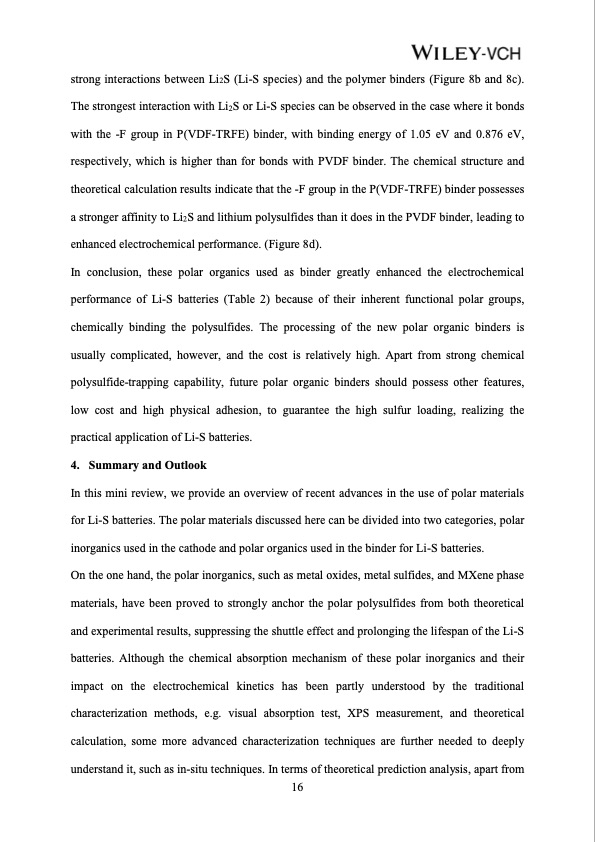
PDF Publication Title:
Text from PDF Page: 018
strong interactions between Li2S (Li-S species) and the polymer binders (Figure 8b and 8c). The strongest interaction with Li2S or Li-S species can be observed in the case where it bonds with the -F group in P(VDF-TRFE) binder, with binding energy of 1.05 eV and 0.876 eV, respectively, which is higher than for bonds with PVDF binder. The chemical structure and theoretical calculation results indicate that the -F group in the P(VDF-TRFE) binder possesses a stronger affinity to Li2S and lithium polysulfides than it does in the PVDF binder, leading to enhanced electrochemical performance. (Figure 8d). In conclusion, these polar organics used as binder greatly enhanced the electrochemical performance of Li-S batteries (Table 2) because of their inherent functional polar groups, chemically binding the polysulfides. The processing of the new polar organic binders is usually complicated, however, and the cost is relatively high. Apart from strong chemical polysulfide-trapping capability, future polar organic binders should possess other features, low cost and high physical adhesion, to guarantee the high sulfur loading, realizing the practical application of Li-S batteries. 4. Summary and Outlook In this mini review, we provide an overview of recent advances in the use of polar materials for Li-S batteries. The polar materials discussed here can be divided into two categories, polar inorganics used in the cathode and polar organics used in the binder for Li-S batteries. On the one hand, the polar inorganics, such as metal oxides, metal sulfides, and MXene phase materials, have been proved to strongly anchor the polar polysulfides from both theoretical and experimental results, suppressing the shuttle effect and prolonging the lifespan of the Li-S batteries. Although the chemical absorption mechanism of these polar inorganics and their impact on the electrochemical kinetics has been partly understood by the traditional characterization methods, e.g. visual absorption test, XPS measurement, and theoretical calculation, some more advanced characterization techniques are further needed to deeply understand it, such as in-situ techniques. In terms of theoretical prediction analysis, apart from 16PDF Image | Advances in Polar Materials for Lithium-Sulfur Batteries

PDF Search Title:
Advances in Polar Materials for Lithium-Sulfur BatteriesOriginal File Name Searched:
212718644.pdfDIY PDF Search: Google It | Yahoo | Bing
Sulfur Deposition on Carbon Nanofibers using Supercritical CO2 Sulfur Deposition on Carbon Nanofibers using Supercritical CO2. Gamma sulfur also known as mother of pearl sulfur and nacreous sulfur... More Info
CO2 Organic Rankine Cycle Experimenter Platform The supercritical CO2 phase change system is both a heat pump and organic rankine cycle which can be used for those purposes and as a supercritical extractor for advanced subcritical and supercritical extraction technology. Uses include producing nanoparticles, precious metal CO2 extraction, lithium battery recycling, and other applications... More Info
| CONTACT TEL: 608-238-6001 Email: greg@infinityturbine.com | RSS | AMP |